Results 4,781 to 4,790 of 8492
Thread Information
Users Browsing this Thread
There are currently 2 users browsing this thread. (0 members and 2 guests)
-
12-02-2013, 06:15 AM #4781Senior Member


- Join Date
- May 2007
- Location
- South West Florida (Behind friendly lines but still in Occupied Territory)
- Posts
- 117,696

 Homestead Survival
Homestead Survival
http://thehomesteadsurvival.com/fall.../#.UobO4OJnOIw
Fall Season Preventive Maintenance Checklist for Homeowners
Chores to do before Winter so stuff does not break at the worst possible moment.
Join our efforts to Secure America's Borders and End Illegal Immigration by Joining ALIPAC's E-Mail Alerts network (CLICK HERE)
-
12-02-2013, 06:16 AM #4782Senior Member


- Join Date
- May 2007
- Location
- South West Florida (Behind friendly lines but still in Occupied Territory)
- Posts
- 117,696

 Homestead Survival
Homestead Survival
http://thehomesteadsurvival.com/emer.../#.UobOAOJnOIw
How to Get Emergency Power from a Phone Line
Did you know that phone lines will still work even in a power outage ?Join our efforts to Secure America's Borders and End Illegal Immigration by Joining ALIPAC's E-Mail Alerts network (CLICK HERE)
-
12-02-2013, 06:17 AM #4783Senior Member


- Join Date
- May 2007
- Location
- South West Florida (Behind friendly lines but still in Occupied Territory)
- Posts
- 117,696

 Pinterest Mom
Pinterest Mom
Bucket boss $7 at Home Depot
This is perfect for storing your kiddos art supplies!!!Join our efforts to Secure America's Borders and End Illegal Immigration by Joining ALIPAC's E-Mail Alerts network (CLICK HERE)
-
12-02-2013, 06:19 AM #4784Senior Member


- Join Date
- May 2007
- Location
- South West Florida (Behind friendly lines but still in Occupied Territory)
- Posts
- 117,696

Fun Recipes
http://www.myrecipes.com/recipe/sunn...0000001831973/
Sunny Skillet BreakfastJoin our efforts to Secure America's Borders and End Illegal Immigration by Joining ALIPAC's E-Mail Alerts network (CLICK HERE)
-
12-02-2013, 06:21 AM #4785Senior Member


- Join Date
- May 2007
- Location
- South West Florida (Behind friendly lines but still in Occupied Territory)
- Posts
- 117,696
Soap Making 101 – Making Cold Process Soap

While there are other methods of making soap (hot process and melt & pour),this tutorial will provide a basic overview on how to make your own all natural cold process soaps. It will be added to the Soapmaking page on my blog along with other helpful links and recipes, so be sure to bookmark or pin it for easy reference.
This is not a stand-alone reference. Go to YouTube and watch some videos, do some Google searches and by all means check out great sites like The Soap Queen!
Making soap is one of my favorite hobbies. There are so many ways to personalize a single recipe, that I rarely make the same soap twice! Once you get the hang of it, you will never want to go back to store-bought again!
A few things to note, before we start:
- Many people are afraid to make soap because it involves handling lye. I know that feeling, because I was the same way! I had my husband do that part at first until I got more comfortable with the idea. Lye requires caution, but you also just need to employ the same common sense you’d use for any potentially dangerous situation such as cooking with a hot stove, or driving down the road in your car. Handle the lye with proper protective gloves and eye wear along with a healthy dose of respect. If you’re careful, you’re not likely to get splashes, but just in case, wear long sleeves. Do NOT involve your children in this activity. There are other fun ways they can “make” herbal soap; check out this post on Making Soap Without Handling Lye.
- This is just an overview. There are many tutorials and books out there that cover soap making. I have some listed on my Soapmaking Page and a Google search will help you find others. It’s prudent to do your research and view the art from many perspectives before attempting.
- An accurate digital scale is essential! I used this exact one that was purchased from Amazon.com for five years before it broke (and by that, I mean it stopped measuring in anything but grams – which is still usable, but not always useful for my various projects.) I bought a similar replacement at Walmart that also works great.
- The links to the digital scale and stick blender in this article are Amazon affiliate links. That means if you click on them and make a purchase, I earn a small commission. This costs nothing extra for you, but does help me afford to keep doing what I do. (Thank you!)
 Having said that though, there’s a good chance you can find suitable items locally as well.
Having said that though, there’s a good chance you can find suitable items locally as well.
Okay! Now, we’re ready to start! You’ll want to do the following things:
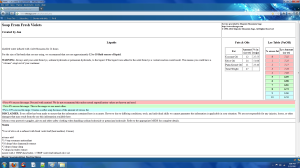
- (1.) Choose a recipe and run it through a lye calculator, especially if you decide to make changes to it. Each type of oil requires a different amount of lye to saponify (turn into soap.) So, if you’re out of the castor oil called for in a recipe and want to use shea butter instead, you’re going to need a different amount of lye or your soap will end up too harsh or too soft. I like to use the Majestic Mountain Sage Lye Calculator. Just plug your recipe into the blanks and calculate the lye needed. If you click the screenshot above, you’ll see it gives a range of liquid to use and a range of lye. I use around the 6 for lye and a midway point for the water/liquid (about 15 ounces in the example above.)
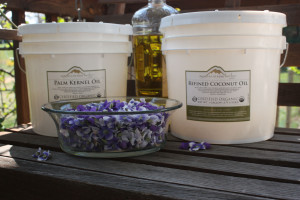
- (2.) Assemble your ingredients and safety gear. Lye is sometimes hard to find; my local Tractor Supply store carries two containers at a time and I found a small, local Mom & Pop type hardware store that has a few as well. Make sure the bottle says Sodium Hydroxide and nothing else. You may have to order online. If so, here are two sources: Brushy Mountain Bee Farm and Bramble Berry.
- I buy my oils & butters from Mountain Rose Herbs, but you can also check your local grocery and health food stores. Don’t forget you’ll need heat & chemical proof gloves and safety goggles along with a kitchen or candy thermometer (a separate one used strictly for soap and not food use.) Wear long sleeves in case any lye splashes on your arms. (This has not happened to me in 10 years of soapmaking, but it’s always better to be safe than sorry!)

- (3.) Prepare your molds by lining with parchment paper. I have homemade wooden box molds that my dad and brother made for me, but you can also buy them from several places online such as Bramble Berry. I’ve even seen people use rubbermaid containers or heavy duty cardboard boxes. A quick google search will likely give you plenty of inspiration!
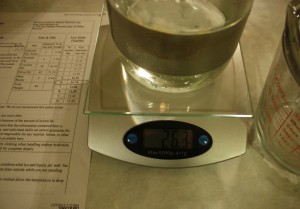
- (4.) Now, we start measuring stuff. First, you’ll want to measure out your water into a heat proof tempered glass jar, pyrex measuring cup, stainless steel or heavy duty polypropylene plastic (recycle symbol 5) container. [NOTE: I've been told that glass/pyrex can weaken over time and shatter, so to be absolutely safe, use one of the alternatives.] Mark this container clearly with a symbol such as a skull and crossbones and don’t put it in your fridge or on the counter where someone might mistake it for a beverage.
- All soap ingredients should be weighed with a digital scale, this includes your liquids. This picture shows me measuring water for a recipe that called for 20 to 31 ounces of liquid. I decided on a mid-range of 26 oz. You can see I went over .3 ounces. This is okay for liquids, but not okay for oils and most definitely not okay for lye. Those need to be precise. More liquid means your soap takes a bit longer to set up (useful if you’re adding honey or beeswax or other items that speed up things) and less liquid means it sets up and is ready to pour into molds faster.
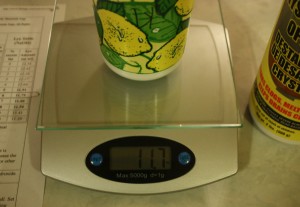
- (5.) Next, measure out your lye. (Make sure you have on those gloves and goggles!) I use an old plastic cup, labeled “Lye” in several places all over with a Sharpie. I pour slowly and carefully then immediately re-cap the lye container and place it far from the reach of children and pets. I take a wet paper towel and thoroughly wipe down the scale and surrounding area in case a tiny grain got loose. Then I do it again with a fresh paper towel. This may seem over-kill, but I have kids and pets and just one tiny grain accidentally picked up and rubbed into an eye or eaten wouldn’t be cool. I’d rather take a few minutes to be safe now than sorry later.
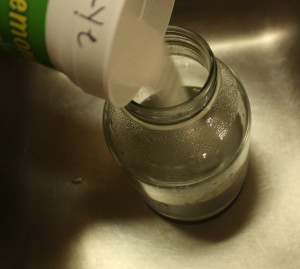
- (6.) Pour the lye into the water (or other liquid.) I do this in my kitchen sink in order to catch any splashes or drips and just in case I have a “volcano.” This only happened to me once because I tried to pour my lye into a very hot herbal tea. I should have been patient and waited for it to cool first, but did not and had to start all over. So, make sure you pour the lye into water that is cool or no warmer than room temp. Also, you always add the lye to the liquid and not the other way around (the other cause of lye volcanoes.) This mixture shoots up to over 200 degrees F quickly, so use caution when handling. Avoid directly breathing in the fumes. (I keep the window over my kitchen sink opened during this step or work outside on my back deck. If you don’t have proper ventilation, consider wearing a mask.) Stir with a long wooden spoon or rubber spatula until fully dissolved and set in a safe place, out of reach of children and pets, until it cools to about 90 to 125 degrees.
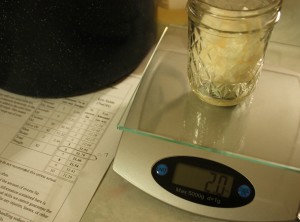
- (7.) While the lye solution is cooling, weigh out the oils and butters called for in your recipe. Place these in an enamel or stainless steel pot, that you plan to use for soap making only. (Do not use aluminum during any stage of the soap making process.) Turn the heat on low and gently heat the oils until they reach 90-125 degrees F.
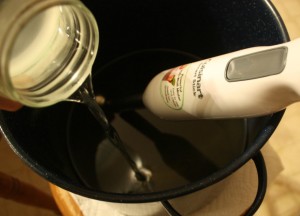
- (8.) Before mixing, make sure your lye and oils are roughly the same temperature in the range of 90 – 125 degrees F. I sometimes add an ice cube or two to my lye solution to cool it faster (remember the water amount can be adjusted by this small amount) or set my pan of oil down into a sink filled with a few inches of water and ice cubes if it needs cooling. Temperature is a subjective, personal preference that varies between soap-makers. Some will only mix at higher temperatures than I list while others let everything sit overnight and mix the next morning at room temperature. The main thing is that your lye solution and oils are about the same temperature when you mix them. Once the desired temps are reached, slowly drizzle your lye solution into your pot containing oils and butters.
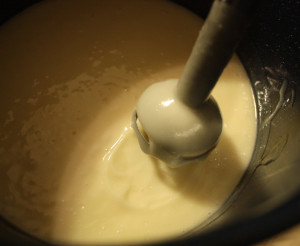
- (9.) Using a stick blender, start combining the lye solution and oils, stopping to occasionally stir and check consistency. It only takes a few minutes for most of my recipes to reach “trace” – which means when you drizzle a small bit of the soap mixture over the surface, it will leave a faint pattern or trace before sinking back into the mixture.(Click on the picture above, which demonstrates this.) My first several batches of soap were made without using a stick blender. Every single one failed. I highly highly HIGHLY recommend using one. I have one by Cuisinart that I’ve had for many years. Make sure you use it strictly for soap making and not for food use. Once trace is reached, you’ll add any extras such as honey, oatmeal, natural colorants, and essential oils and blend for just a bit more until they are all incorporated.
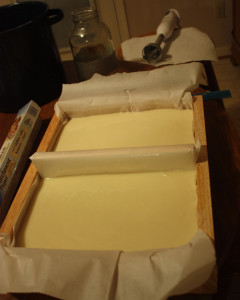
- (10.) Working quickly, pour the soap into your prepared molds, smoothing the top with a rubber spatula or wooden spoon. Pick up your mold and give it a few sharp raps on the table or counter surface to help get rid of any little air bubbles that may have formed. The soap is still caustic at this point, so keep your gloves on and be aware that the mixture can burn your skin. If that happens you can rinse thoroughly with water or pour vinegar over the spot to offset the alkalinity (or both.)
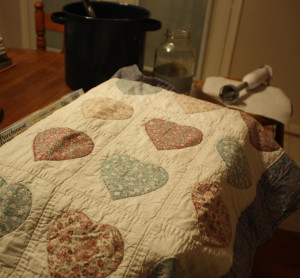
- (11.) Cover with the mold top, then several layers of blankets and quilts to make sure the soap is well insulated and retains the heat needed to finish saponifying. Leave undisturbed for about 24 to 36 hours.
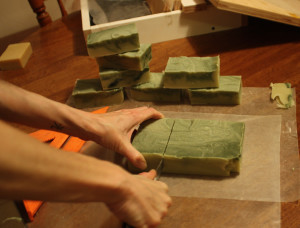
- (12.) Unmold your block of soap. You can cut it into bars right away or later. I like to do it fairly soon after making, so that the soap is still soft and easy to cut. Use a ruler and a knife to cut into desired sizes. Let the bars cure in the open air on pieces of wax paper or brown paper, turning occasionally, for about 4 weeks. Since I almost always superfat my soaps, (which means I put in extra oils that the lye does not transform to soap), they are gentle enough to start testing after three weeks. I always test on myself a few days before trying out on other family members, just to be safe.
This wraps up my post on the basics of soap making. Remember, this is just an overview! I did not cover every tiny detail there is to know about soap making because that is impractical for the space limitations of a single blog post. Be sure to check out the links and books on my Soapmaking Page so you can research more thoroughly before you make your first batch.
SOURCE: http://thenerdyfarmwife.com/soap-mak...-process-soap/
http://asheepnomore.net/2013/11/18/s...-process-soap/Join our efforts to Secure America's Borders and End Illegal Immigration by Joining ALIPAC's E-Mail Alerts network (CLICK HERE)
-
12-02-2013, 06:22 AM #4786Senior Member


- Join Date
- May 2007
- Location
- South West Florida (Behind friendly lines but still in Occupied Territory)
- Posts
- 117,696

 Homestead Survival
Homestead Survival
http://thehomesteadsurvival.com/wood.../#.UoqyfeJnOIw
Wood Fired Clay Pizza Oven Build Project
Can bake wood fired pizzas and grill or broil your favorite meats and vegetables all at the same timeJoin our efforts to Secure America's Borders and End Illegal Immigration by Joining ALIPAC's E-Mail Alerts network (CLICK HERE)
-
12-02-2013, 06:23 AM #4787Senior Member


- Join Date
- May 2007
- Location
- South West Florida (Behind friendly lines but still in Occupied Territory)
- Posts
- 117,696

 Homestead Survival
Homestead Survival
http://thehomesteadsurvival.com/cowb.../#.Uok_6uJnOIw
Cowboy Caviar RecipeJoin our efforts to Secure America's Borders and End Illegal Immigration by Joining ALIPAC's E-Mail Alerts network (CLICK HERE)
-
12-02-2013, 06:24 AM #4788Senior Member


- Join Date
- May 2007
- Location
- South West Florida (Behind friendly lines but still in Occupied Territory)
- Posts
- 117,696

 Homestead Survival
Homestead Survival
http://thehomesteadsurvival.com/home.../#.Uoj1UuJnOIw
Homemade ” Big Batch ” Laundry Soap Recipe
Tips of how to use & how to solve some issues !
Thank you to Pat S. (a loyal reader) who shared her recipe !Join our efforts to Secure America's Borders and End Illegal Immigration by Joining ALIPAC's E-Mail Alerts network (CLICK HERE)
-
12-02-2013, 06:26 AM #4789Senior Member


- Join Date
- May 2007
- Location
- South West Florida (Behind friendly lines but still in Occupied Territory)
- Posts
- 117,696
Delicious Pizza Roses
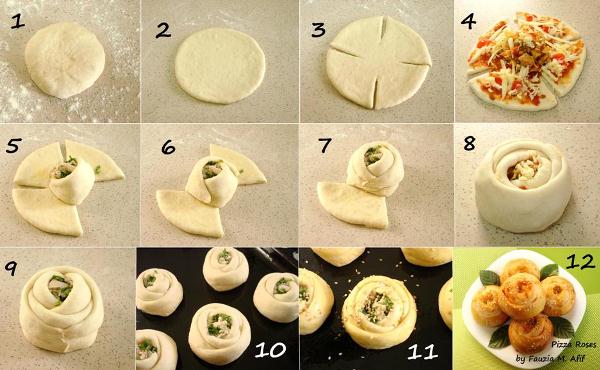
We came up again with a creative recipe like Rose Rolls from Fauzia M. Afif because are really good. These creative pizza roses are perfect for when you have guests. We guarantee that they will remain pleasantly surprised, as they are so delicious especially when warm!For the filling, you need to use Pizza Sauce, Spicy Chicken, and some shredded mozzarella and cheddar cheese.STEP 1: Divide the dough into 8 sections and shape them into neat balls.
STEP 2: Now you can start shaping the Roses. Roll out each ball to about 4″ diameter.
STEP 3: Brush a bit of butter on the circle of dough. Make 4 diagonal slits, leaving the center intact.
STEP 4: Apply a thin coating of pizza sauce, some filling in the center and shredded cheese all over.
STEP 5: Take one of the sections and cover the side of the filling with it.
STEP 6: Take the opposite side’s section and cover the other side of the filling with it.
STEP 7 & 8: Repeat with the last two sections.
STEP 9: Pinch the dough on the side to seal it. Repeat until all rose-rolls are ready.
STEP 10: Place the prepared rolls on a greased tray.
STEP 11: Pre-heat your oven to 180 C. If using the Pizza dough, allow the roses to rest and double in size. If using the Rose Rolls dough, there will be no need to let the roses rise a second time. Brush each rose gently with egg yolk mixed with a tsp. of milk. Sprinkle with sesame seeds. Bake for about 15-20 minutes or until the tops are golden and the rolls are ready.
STEP 12: Remove and brush them with melted butter. Keep them covered until time of serving so that they stay soft. Enjoy your delicious Pizza Roses!!
Tags: creative pizza, creative recipe, Pizza Roses, Pizza Sauce
http://www.goodshomedesign.com/delicious-pizza-roses/Join our efforts to Secure America's Borders and End Illegal Immigration by Joining ALIPAC's E-Mail Alerts network (CLICK HERE)
-
12-02-2013, 06:27 AM #4790Senior Member


- Join Date
- May 2007
- Location
- South West Florida (Behind friendly lines but still in Occupied Territory)
- Posts
- 117,696
Join our efforts to Secure America's Borders and End Illegal Immigration by Joining ALIPAC's E-Mail Alerts network (CLICK HERE)


 210Likes
210Likes LinkBack URL
LinkBack URL About LinkBacks
About LinkBacks




 Reply With Quote
Reply With Quote



Thank you! We are ready to roll.
05-01-2024, 02:07 PM in illegal immigration Announcements